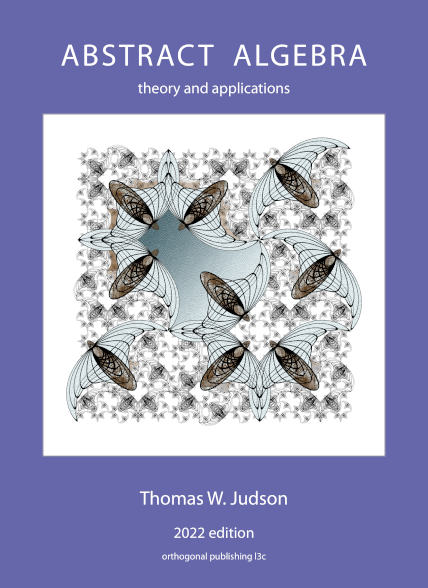Exercises 6.5 Exercises
1.
Suppose that \(G\) is a finite group with an element \(g\) of order \(5\) and an element \(h\) of order \(7\text{.}\) Why must \(|G| \geq 35\text{?}\)
2.
Suppose that \(G\) is a finite group with \(60\) elements. What are the orders of possible subgroups of \(G\text{?}\)
3.
Prove or disprove: Every subgroup of the integers has finite index.
4.
Prove or disprove: Every subgroup of the integers has finite order.
5.
List the left and right cosets of the subgroups in each of the following.
\(\langle 8 \rangle\) in \({\mathbb Z}_{24}\)
\(\langle 3 \rangle\) in \(U(8)\)
\(3 {\mathbb Z}\) in \({\mathbb Z}\)
\(A_4\) in \(S_4\)
\(A_n\) in \(S_n\)
\(D_4\) in \(S_4\)
\({\mathbb T}\) in \({\mathbb C}^\ast\)
\(H = \{ (1), (1 \, 2 \, 3), (1 \, 3 \, 2) \}\) in \(S_4\)
6.
Describe the left cosets of \(SL_2( {\mathbb R} )\) in \(GL_2( {\mathbb R})\text{.}\) What is the index of \(SL_2( {\mathbb R} )\) in \(GL_2( {\mathbb R})\text{?}\)
7.
Verify Euler's Theorem for \(n = 15\) and \(a = 4\text{.}\)
8.
Use Fermat's Little Theorem to show that if \(p = 4n + 3\) is prime, there is no solution to the equation \(x^2 \equiv -1 \pmod{p}\text{.}\)
9.
Show that the integers have infinite index in the additive group of rational numbers.
10.
Show that the additive group of real numbers has infinite index in the additive group of the complex numbers.
11.
Let \(H\) be a subgroup of a group \(G\) and suppose that \(g_1, g_2 \in G\text{.}\) Prove that the following conditions are equivalent.
\(\displaystyle g_1 H = g_2 H\)
\(\displaystyle H g_1^{-1} = H g_2^{-1}\)
\(\displaystyle g_1 H \subset g_2 H\)
\(\displaystyle g_2 \in g_1 H\)
\(\displaystyle g_1^{-1} g_2 \in H\)
12.
If \(ghg^{-1} \in H\) for all \(g \in G\) and \(h \in H\text{,}\) show that right cosets are identical to left cosets. That is, show that \(gH = Hg\) for all \(g \in G\text{.}\)
13.
What fails in the proof of Theorem 6.8 if \(\phi : {\mathcal L}_H \rightarrow {\mathcal R}_H\) is defined by \(\phi( gH ) = Hg\text{?}\)
14.
Suppose that \(g^n = e\text{.}\) Show that the order of \(g\) divides \(n\text{.}\)
15.
The cycle structure of a permutation \(\sigma\) is defined as the unordered list of the sizes of the cycles in the cycle decomposition \(\sigma\text{.}\) For example, the permutation \(\sigma = (1 \, 2)(3 \, 4 \, 5)(7 \, 8)(9)\) has cycle structure \((2,3,2,1)\) which can also be written as \((1, 2, 2, 3)\text{.}\)
Show that any two permutations \(\alpha, \beta \in S_n\) have the same cycle structure if and only if there exists a permutation \(\gamma\) such that \(\beta = \gamma \alpha \gamma^{-1}\text{.}\) If \(\beta = \gamma \alpha \gamma^{-1}\) for some \(\gamma \in S_n\text{,}\) then \(\alpha\) and \(\beta\) are conjugate.
16.
If \(|G| = 2n\text{,}\) prove that the number of elements of order \(2\) is odd. Use this result to show that \(G\) must contain a subgroup of order 2.
17.
Suppose that \([G : H] = 2\text{.}\) If \(a\) and \(b\) are not in \(H\text{,}\) show that \(ab \in H\text{.}\)
18.
If \([G : H] = 2\text{,}\) prove that \(gH = Hg\text{.}\)
19.
Let \(H\) and \(K\) be subgroups of a group \(G\text{.}\) Prove that \(gH \cap gK\) is a coset of \(H \cap K\) in \(G\text{.}\)
20.
Let \(H\) and \(K\) be subgroups of a group \(G\text{.}\) Define a relation \(\sim\) on \(G\) by \(a \sim b\) if there exists an \(h \in H\) and a \(k \in K\) such that \(hak = b\text{.}\) Show that this relation is an equivalence relation. The corresponding equivalence classes are called double cosets. Compute the double cosets of \(H = \{ (1),(1 \, 2 \, 3), (1 \, 3 \, 2) \}\) in \(A_4\text{.}\)
21.
Let \(G\) be a cyclic group of order \(n\text{.}\) Show that there are exactly \(\phi(n)\) generators for \(G\text{.}\)
22.
Let \(n = p_1^{e_1} p_2^{e_2} \cdots p_k^{e_k}\text{,}\) where \(p_1, p_2, \ldots, p_k\) are distinct primes. Prove that
23.
Show that
for all positive integers \(n\text{.}\)
